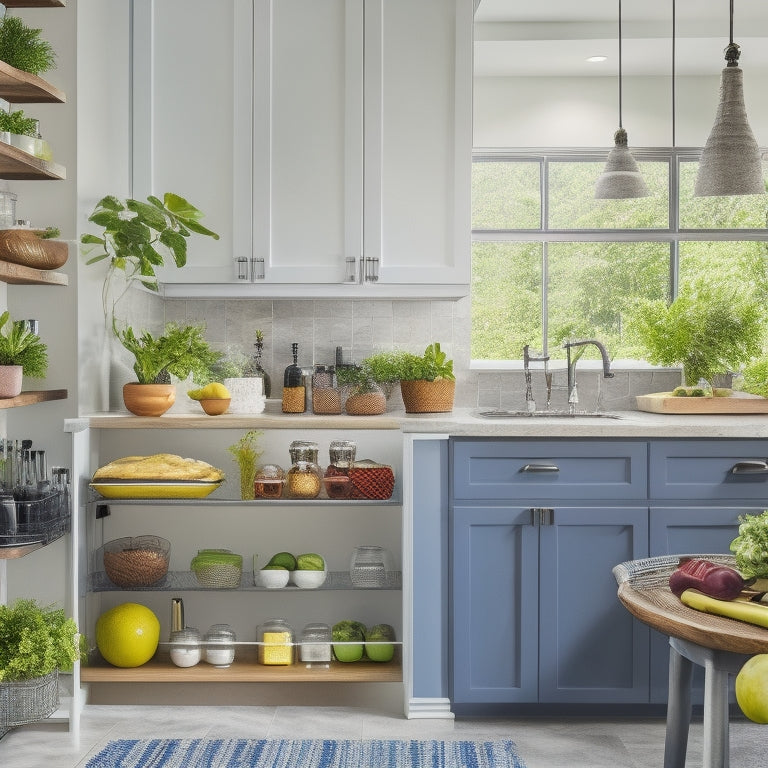
5 Essential Kitchen Storage Tips for Healthy Eating
Share
You're about to discover the secret to healthy eating: a well-organized kitchen! Start by purging your pantry of unhealthy staples and restocking with whole foods like brown rice and quinoa. Next, maximize your vertical storage space with shelves, hooks, and pegboards to free up counter space. Label and categorize your food groups for easy access, and designate zones for meal prep to streamline your cooking process. Don't forget to utilize hidden storage areas like under-sink drawers and cabinet corners. By implementing these essential storage tips, you'll be well on your way to whipping up healthy meals in no time - and that's just the beginning of your kitchen transformation.
Key Takeaways
• Purge your pantry of unhealthy staples and restock with whole foods to promote healthy eating habits.
• Maximize vertical storage space by installing shelves, hooks, or pegboards to free up counter and floor space.
• Label and categorize food groups into easy-to-access zones, grouping similar items together for quick identification.
• Designate zones for meal prep, such as a prep station, cooking zone, and assembly station, to streamline workstation flow.
• Utilize hidden storage areas, like under-sink storage and cabinet corners, to keep kitchen essentials out of sight but easily accessible.
Optimize Your Pantry for Success
By purging your pantry of unhealthy staples and strategically restocking it with whole, nutrient-dense foods, you'll set yourself up for healthy eating success. This is the foundation of achieving your Pantry Goals.
Start by getting rid of expired or processed foods that can hinder your progress. Take everything out and sort items into three categories: keep, donate/sell, and toss. Be honest with yourself – if you haven't used it in the past year, it's probably safe to let it go. Don't forget to check expiration dates and get rid of anything past its prime.
This process will also help reduce Food Wastes, saving you money and reducing your environmental impact. Once you've purged your pantry, restock with whole foods like brown rice, quinoa, and canned vegetables. Organize your pantry into zones, such as a baking zone or a snack zone, to make meal prep and cooking a breeze.
With a clean and organized pantry, you'll be more likely to make healthy choices and stay on track with your wellness goals.
Maximize Vertical Storage Space
Make the most of your kitchen's vertical space by installing shelves, hooks, or a pegboard to store less frequently used items, freeing up valuable counter and floor space for everyday essentials. This strategic move allows you to keep your kitchen organized, clutter-free, and functional. You'll be amazed at how much more efficient your cooking and meal prep become when you're not tripping over utensils or digging through drawers.
Take advantage of your ceiling's real estate by installing ceiling shelves or overhead storage racks. These are perfect for storing infrequently used cookbooks, special occasion dishes, or bulky kitchen gadgets.
Meanwhile, utilize your walls by adding wall hooks for hanging pots, pans, utensils, or even a kitchen towel. This not only saves space but also adds a touch of elegance to your kitchen.
Label and Categorize Food Groups
Now that your kitchen is organized and clutter-free, you can focus on simplifying meal prep by categorizing your food groups into easy-to-access zones. This step is essential in developing healthy food habits, as it allows you to visualize what you have in stock and plan your meals accordingly.
Start by grouping similar items together, such as grains, proteins, and vegetables. Label each category clearly, so you can quickly identify what you need. Consider the shelf life of each item and store them accordingly. Perishable items, like dairy and meat, should be stored in the front and center, while non-perishable items, like canned goods, can be stored towards the back.
Designate Zones for Meal Prep
Designating specific zones for meal prep in your kitchen helps you stay focused and efficient, allowing you to chop, cook, and assemble healthy meals with ease. This thoughtful approach to your countertop layout streamlines your workstation flow, making meal prep a breeze. By assigning dedicated areas for different tasks, you'll reduce clutter, minimize distractions, and maximize your productivity.
Consider the following zones to include in your meal prep setup:
-
Prep Station: Designate a specific area for chopping, slicing, and dicing ingredients. This zone should be equipped with a sharp knife, cutting board, and necessary utensils.
-
Cooking Zone: Identify a zone for cooking and heating, ensuring easy access to your stovetop, oven, or microwave.
-
Assembly Station: Create a zone for assembling your meals, complete with utensils, plates, and serving dishes.
Utilize Hidden Storage Areas
By capitalizing on hidden storage areas, you can stash away kitchen essentials, freeing up valuable counter space and keeping your meal prep zones clutter-free.
One often-overlooked area is under the sink. Install a slide-out drawer or a pedestal organizer to store items like soap, sponges, and cleaning supplies. This will keep them out of the way but still easily accessible.
Another hidden gem is the cabinet corners. Those hard-to-reach areas can be utilized with the help of carousel-style shelves or corner baskets. These clever solutions allow you to store infrequently used items, like special occasion dishes or cookbooks, without taking up prime real estate in your cabinets.
By maximizing these hidden storage areas, you'll create a more organized and efficient kitchen that makes healthy meal prep a breeze. Plus, you'll feel a sense of accomplishment and control over your kitchen space.
Frequently Asked Questions
How Do I Keep My Kitchen Counters Clutter-Free and Organized?
"You create countertops that sparkle by dividing your space into Countertop Zones, optimizing your Kitchen Workflow. Assign a home for each item, and maintain it daily to keep clutter at bay, making meal prep a breeze, and your kitchen a haven!"
What Are Some Creative Ways to Repurpose Old Kitchen Items?
You're probably thinking, "Can old kitchen items really be repurposed?" And the answer is, absolutely! Try a Vintage Revamp by transforming old containers into Upcycled Containers for a unique storage solution that's both eco-friendly and stylish.
How Can I Store Fresh Herbs to Keep Them Fresh for Longer?
You can store fresh herbs to keep them fresh for longer by creating a mini indoor herb garden or using fresh wrapping techniques like wrapping them in damp paper towels and sealing in airtight containers.
Can I Use Baskets to Store Food Items in My Pantry?
You can totally use baskets to store food items in your pantry, and they'll even elevate your pantry aesthetics! Opt for baskets made from natural materials like wicker or bamboo for a cozy, earthy vibe.
How Often Should I Clean and Reorganize My Kitchen Storage Areas?
"Just like a garden needs pruning to bloom, your kitchen storage areas need a seasonal purge to stay fresh and organized. You'll also want to tend to daily maintenance, wiping down shelves and tidying up, to keep your space thriving."
Related Posts
-

Data Lakes and Warehouses: Unveiling Data Wisdom
Data lakes and warehouses are two distinct data storage solutions that serve different purposes. Data lakes store mas...
